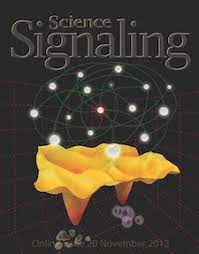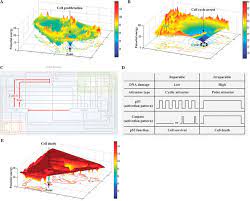

. [Abstract] [Reprint] [Full text] [Summary]
"Featured Cover Article (http://stke.sciencemag.org/content/vol5/issue251/cover.dtl) - the cover caption : This week features a Research Article that describes the application of state-space analysis to the p53 network, which identifies a therapeutic strategy for treating cancer. The image shows a simplified p53 network and a representation of an attractor landscape. The valleys in the landscape represent different outcomes, such as cell cycle arrest or apoptosis, to activation of the p53 network. [Image: Kwang-Hyun Cho, Korea Advanced Institute of Science and Technology]"
"Editor's Summary (http://stke.sciencemag.org/cgi/content/summary/sigtrans;5/251/ra83) : Charting a Deadly Landscape - Signaling pathways exhibit complex regulatory interactions that can make it difficult to predict the outcome of inhibition of components. Choi et al. used a computational approach called attractor landscape analysis to identify how the states of the activity of molecules in the p53 network resulted in specific cellular responses to DNA damage. Conditions that produced a particular type of attractor state, called a cyclic attractor, were associated with pulsatile p53 activity and with the cell entering a state of cell cycle arrest. Furthermore, modeling the combined inhibition of specific components in the pathway suggested a mechanism to enhance the apoptotic response to DNA damage. The p53 dynamics and cellular response of MCF7 cells to the combined treatment verified the computational predictions. Thus, the authors demonstrated the potential application of this method to identify enhanced chemotherapeutic strategies."
"Special Highlight News in Editors' Choice of 'Science', 23 November 2012
(http://www.sciencemag.org/content/338/6110/twil.full) : Viewing the Cancer Landscape - The cellular signaling pathways that control cell physiology are key targets of therapeutic strategies, like those aimed at killing cancer cells. But agents that cause DNA damage in cancer cells lead to cell death through a complicated network of pathways, including positive and negative feedback loops, that control the activity of the tumor suppressor p53. To help clarify more effective strategies to promote cell death in cancer cells, Choi et al. used a computational approach in which the potential energy landscape is mapped as a three-dimensional surface in which depressions represent stable states or ˇ°attractors.ˇ± These attractors represent alternative cell fates. With a simplified network analyzed with a Boolean network model, the authors identified key network components that together could force cells to undergo apoptosis rather than proliferation or cell cycle arrest. Experiments verified that modulation of these two components effectively promoted cell death. The approach may provide a way to address complex system-level data and models to more accurately predict ways to steer cells to adopt a desired physiological state."